Abstract
1. Thermocouples were chronically implanted in various intracranial and extracranial structures in adult cats. Temperature of arterial blood on the proximal and distal sides of the carotid rete was determined by measuring temperature in the aortic arch and at the anterior cerebral arteries. Temperatures of brain stem regions supplied by the carotid rete and by the vertebral—basilar system were determined by measuring temperature in the anterior hypothalamus and the caudal medulla. Nasal mucosal temperature was measured with a thermocouple implanted in the nasal cavity.
2. In a cool environment (25° C), the temperature of anterior cerebral arterial blood was lower than aortic arterial temperature. Anterior cerebral temperature showed shifts which were not present in central (aortic) arterial blood and which were clearly associated with changes in heat loss from the nasal mucosa and with the behaviour of the animal. When the cats were relaxed or in e.e.g. slow-wave sleep, the nasal mucosal temperature was high and the temperature at the anterior cerebral arteries was as much as 0·30° C less than aortic temperature. During behavioural arousal and paradoxical sleep, the nasal mucosal temperature fell and the anterior cerebral arterial temperature rose toward central arterial temperature. Shifts in hypothalamic temperature followed the changes in anterior cerebral arterial temperature. Medullary temperature was higher than aortic temperature and showed shifts which suggested that blood from the rostral circle of Willis mixed with vertebral blood in the basilar artery.
3. When the ambient temperature was raised to 40-45° C the cooling of cerebral arterial blood and brain increased as the rate of thermal panting increased. Respiratory rate increased tenfold and aortic temperature rose by 2·0-2·5 °C. Anterior cerebral arterial temperature fell below aortic temperature by as much as 1° C, hypothalamic temperature dropping in parallel with cerebral arterial temperature. Medullary temperature cooled below aortic temperature during heat exposure, but the temperature drop in the medulla was not as high as in the rostral brain stem.
4. Blowing air into the nasal cavity of anaesthetized cats produced a large, rapid temperature drop at the anterior cerebral arteries and in the hypothalamus, with little effect on central arterial temperature. The same experiments in a dead animal cooled the brain after a longer period of time, suggesting that an active process is involved in the brain cooling observed in living animals.
5. It is concluded that the cooling of the rostral cerebral arterial blood and brain which occurs in cats in a cool environment and is accelerated during thermal panting, is a result of countercurrent heat exchange between arterial blood in the carotid rete and venous blood draining the evaporative surfaces of the upper respiratory passages. Such direct brain cooling during thermal panting has now been demonstrated in the cat, the sheep and the gazelle, and probably explains the high heat tolerance of the carnivores and hoofed mammals in which a rete is present.
Full text
PDF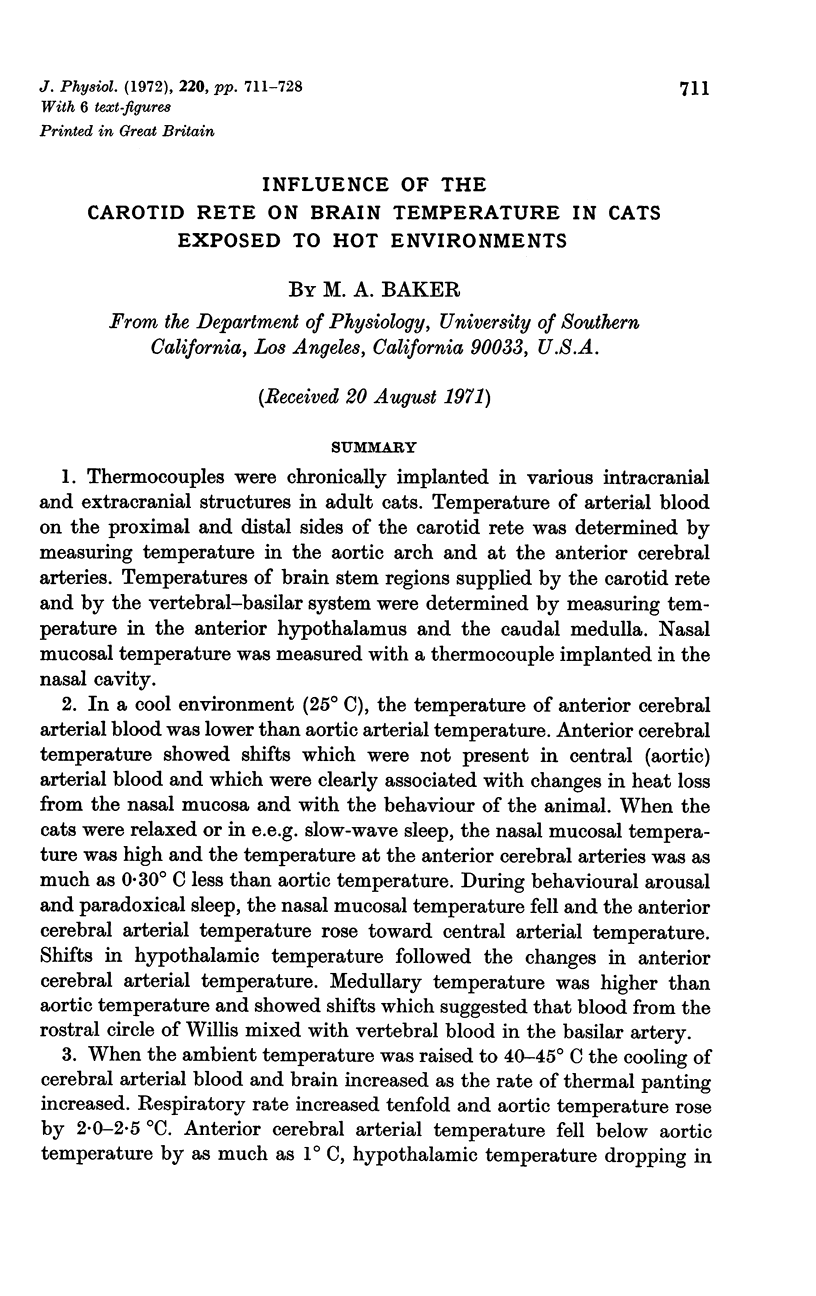
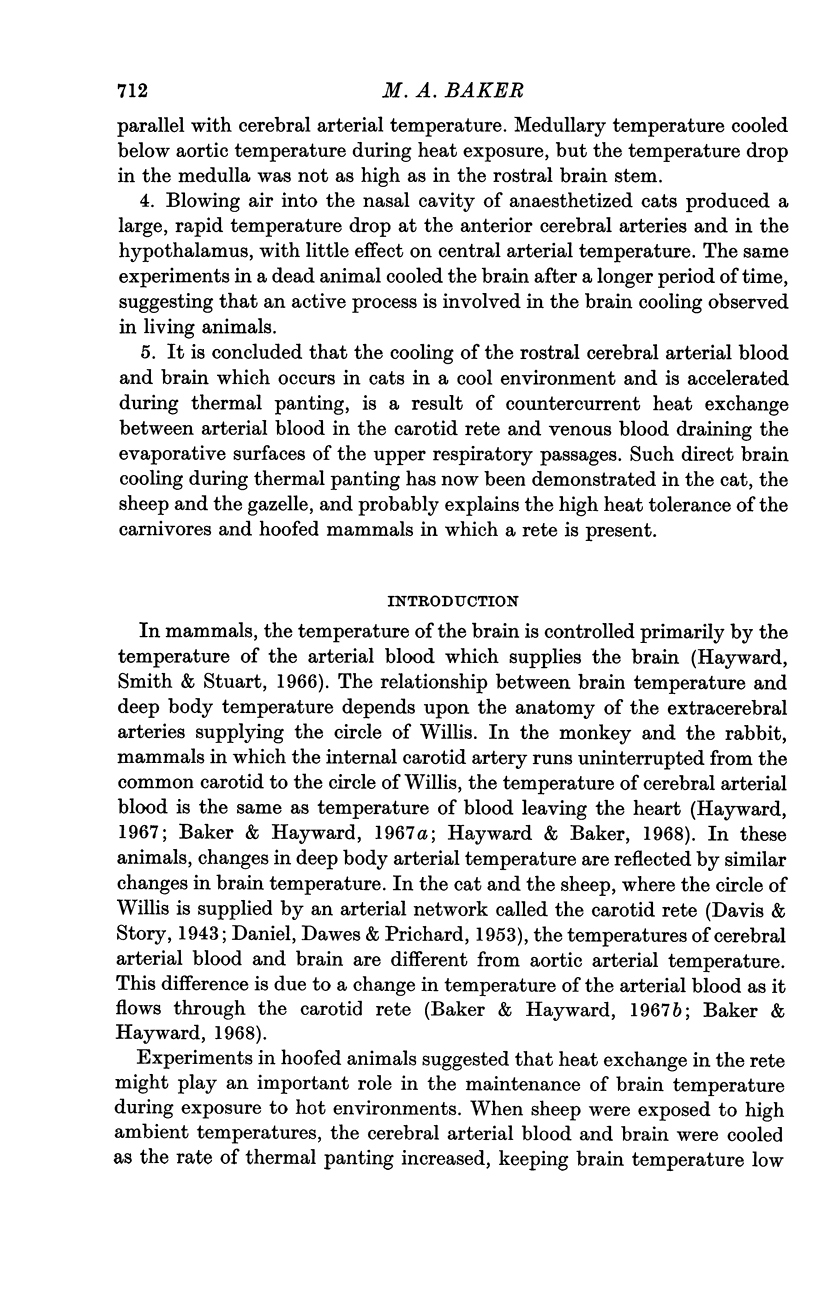

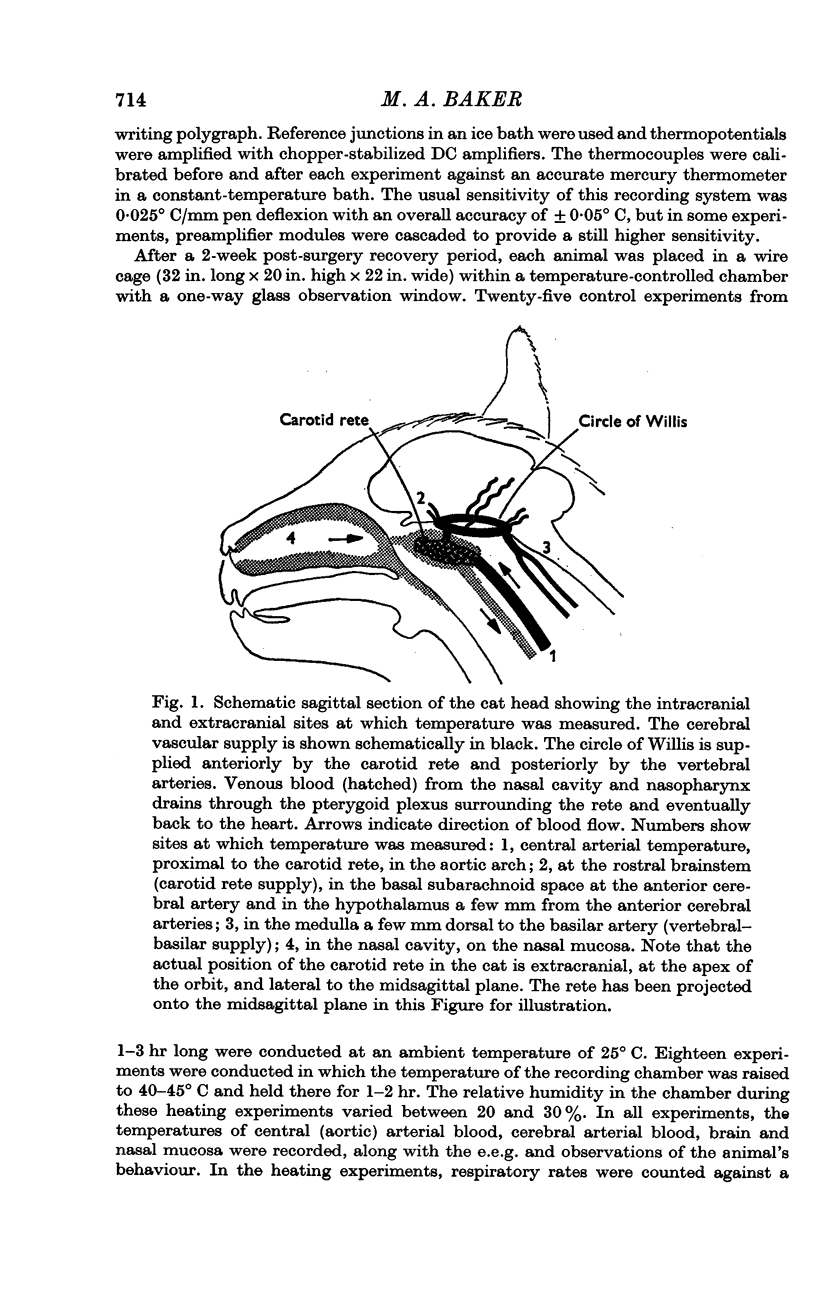


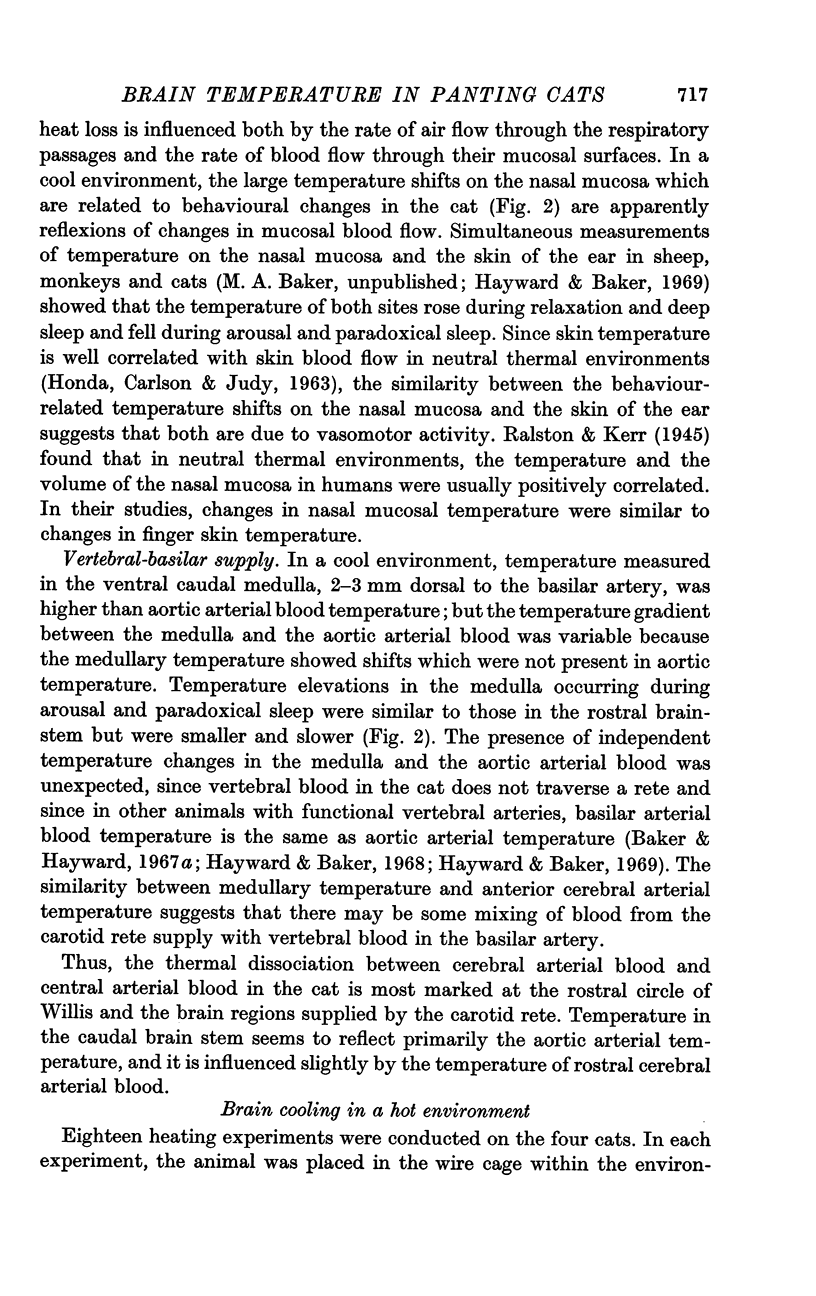
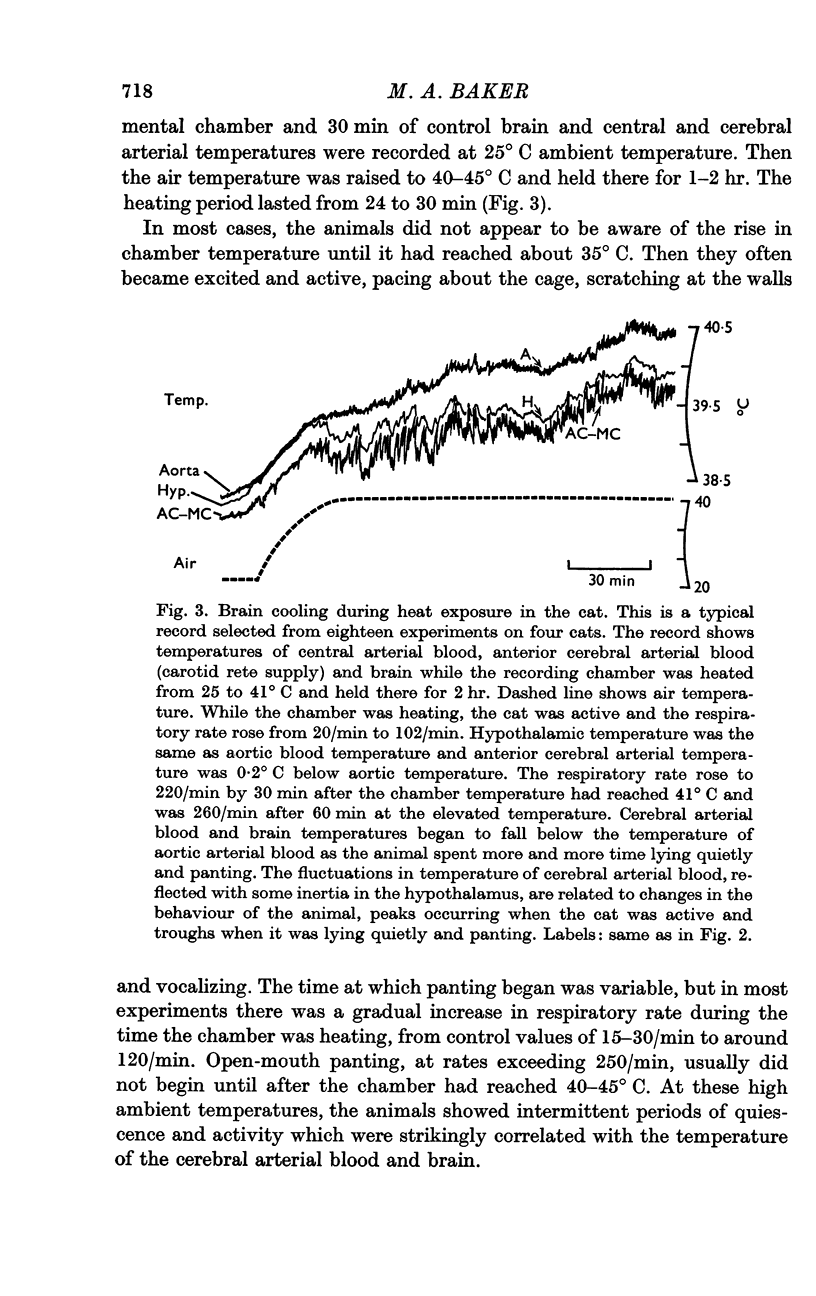
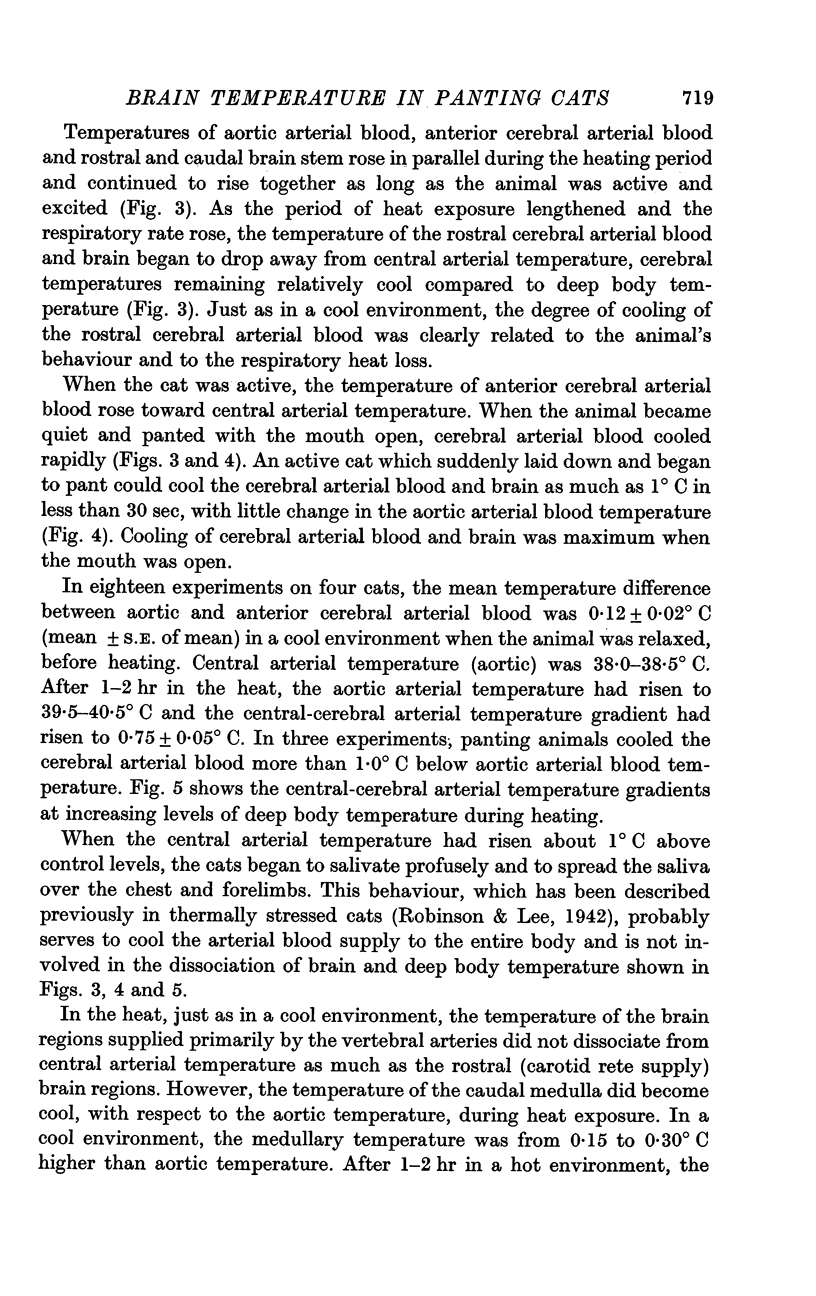

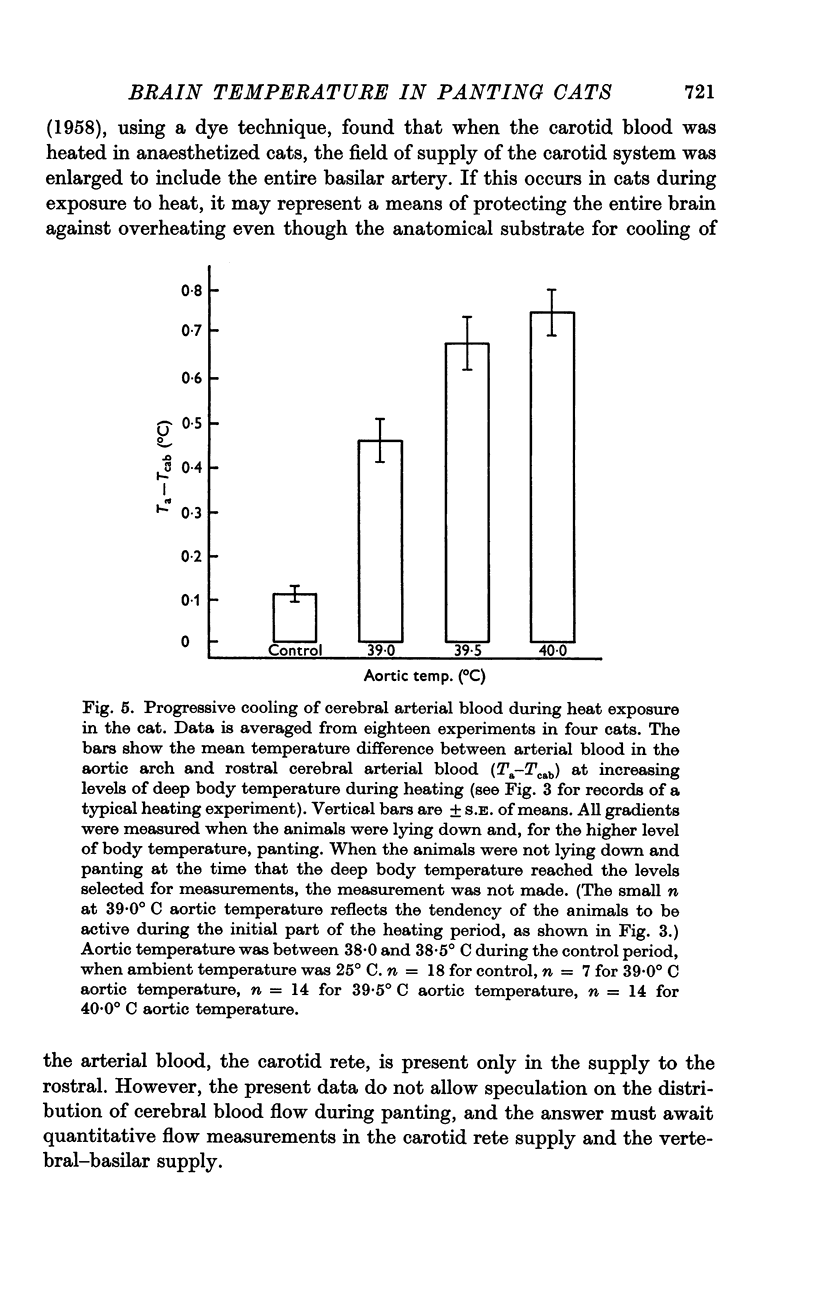
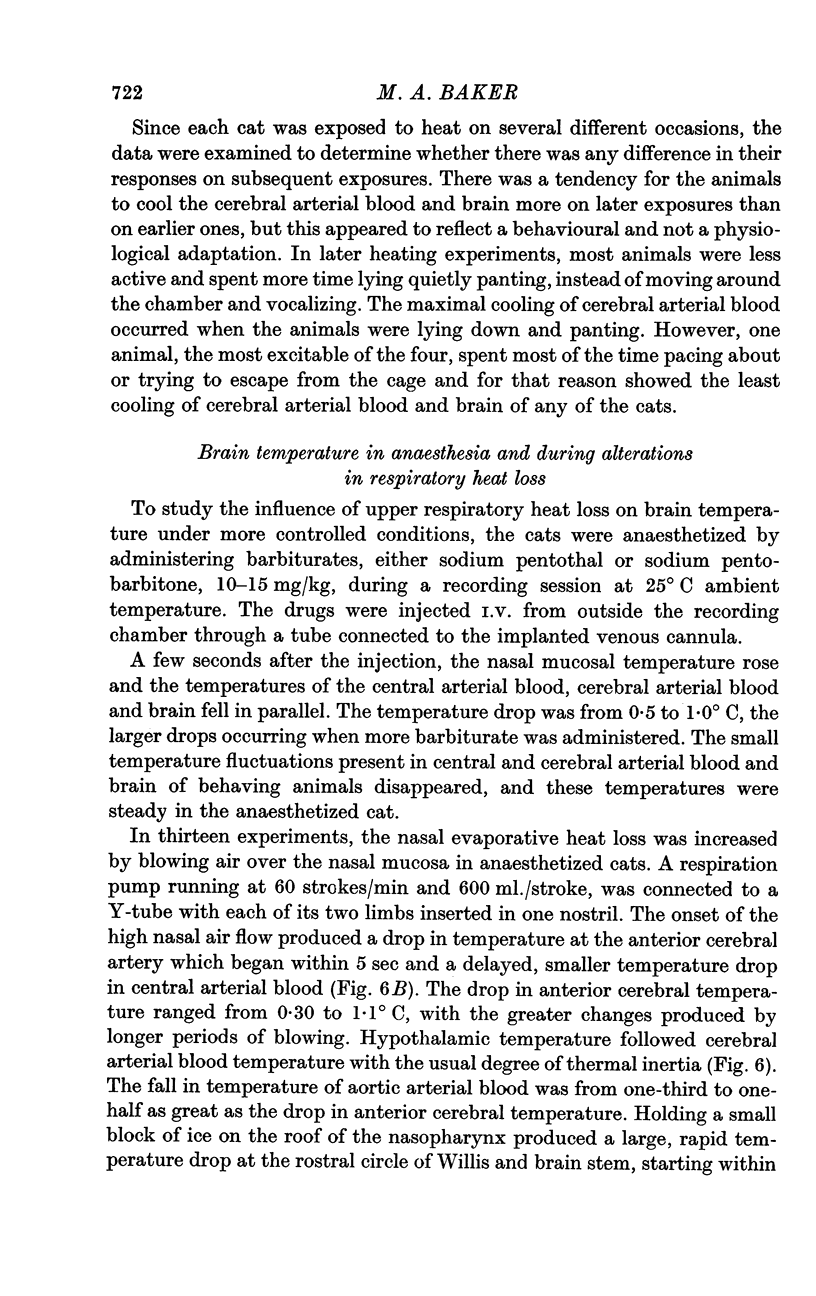
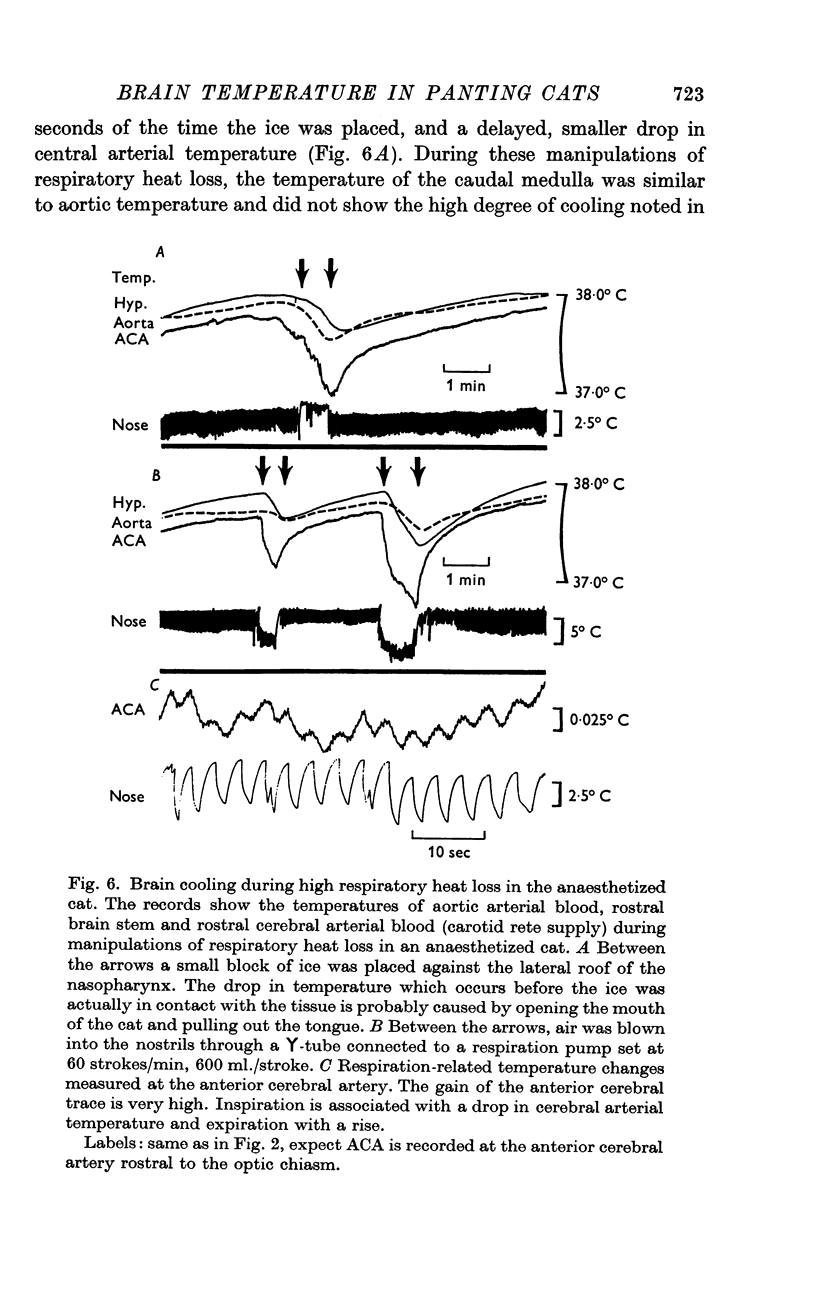

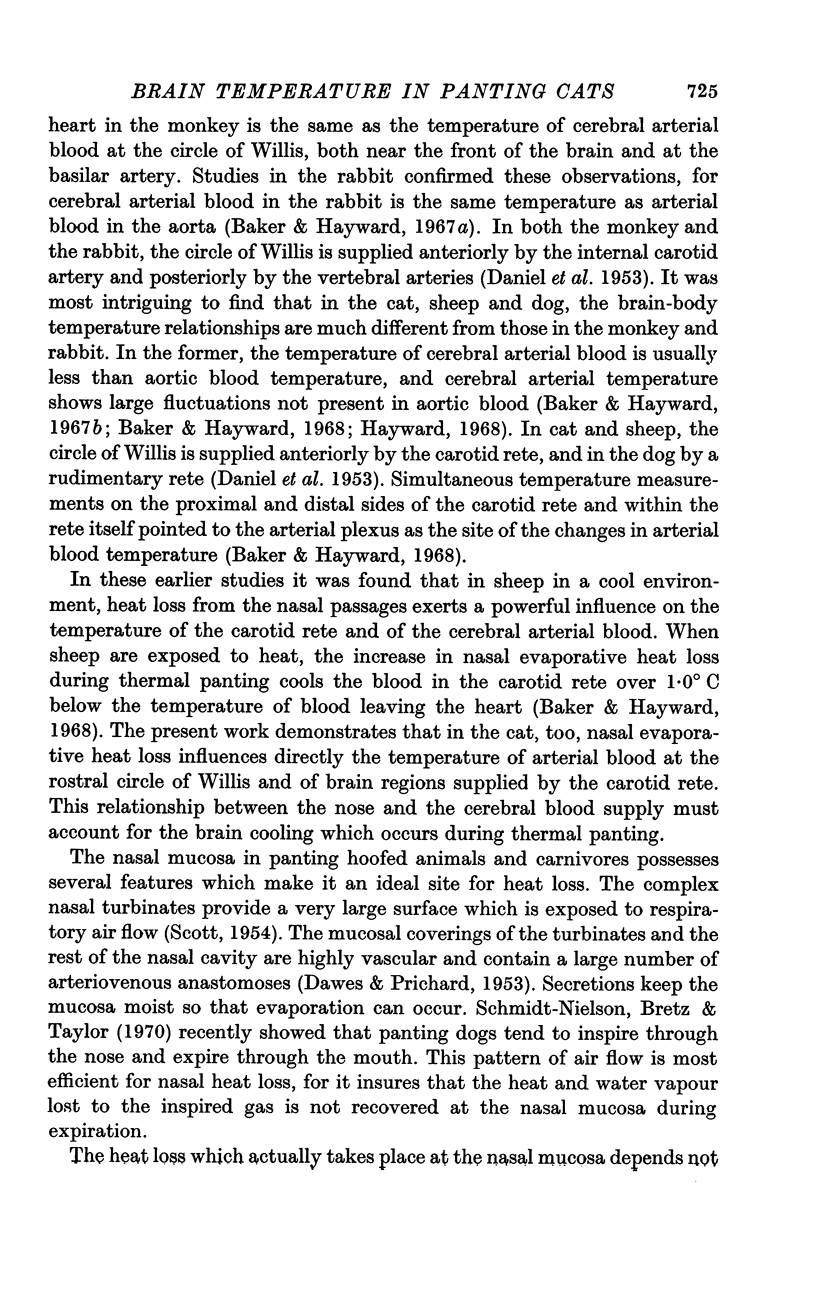
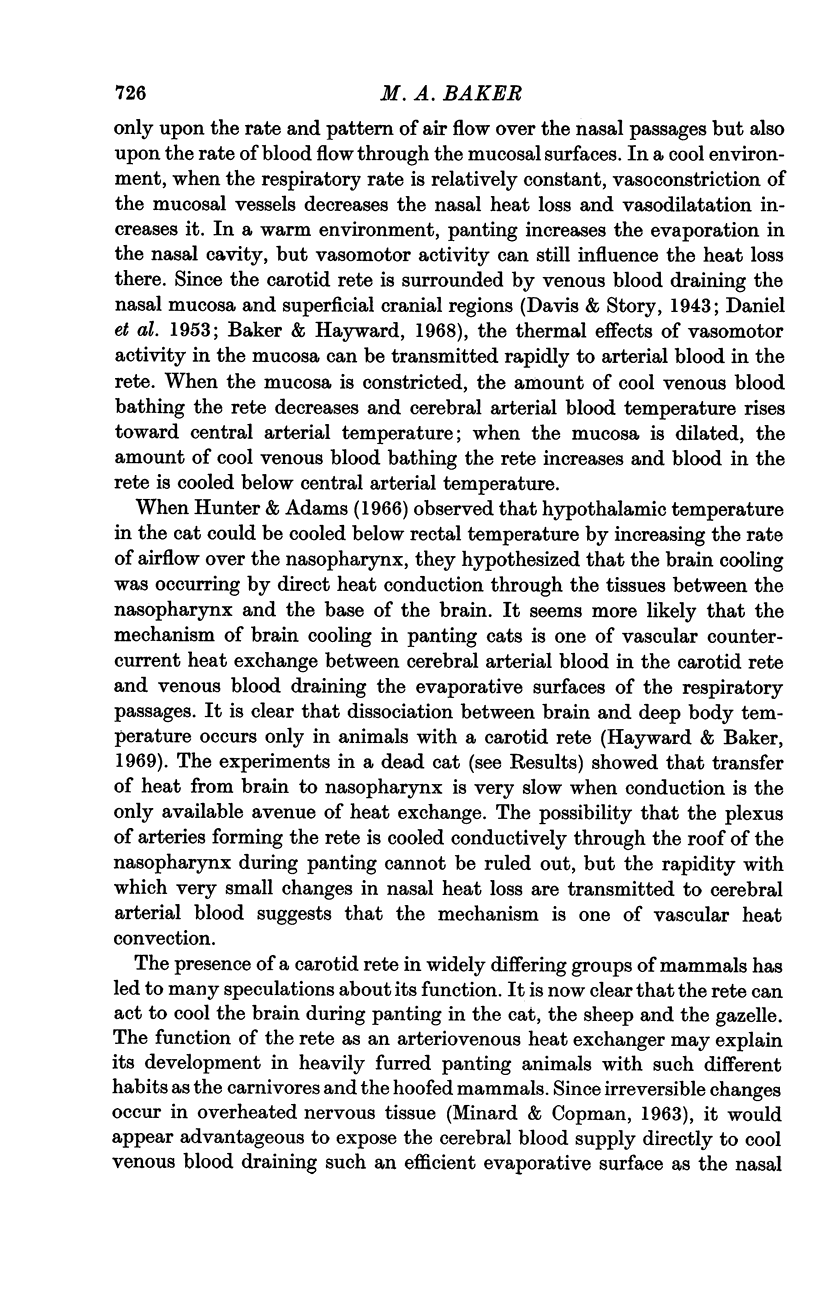
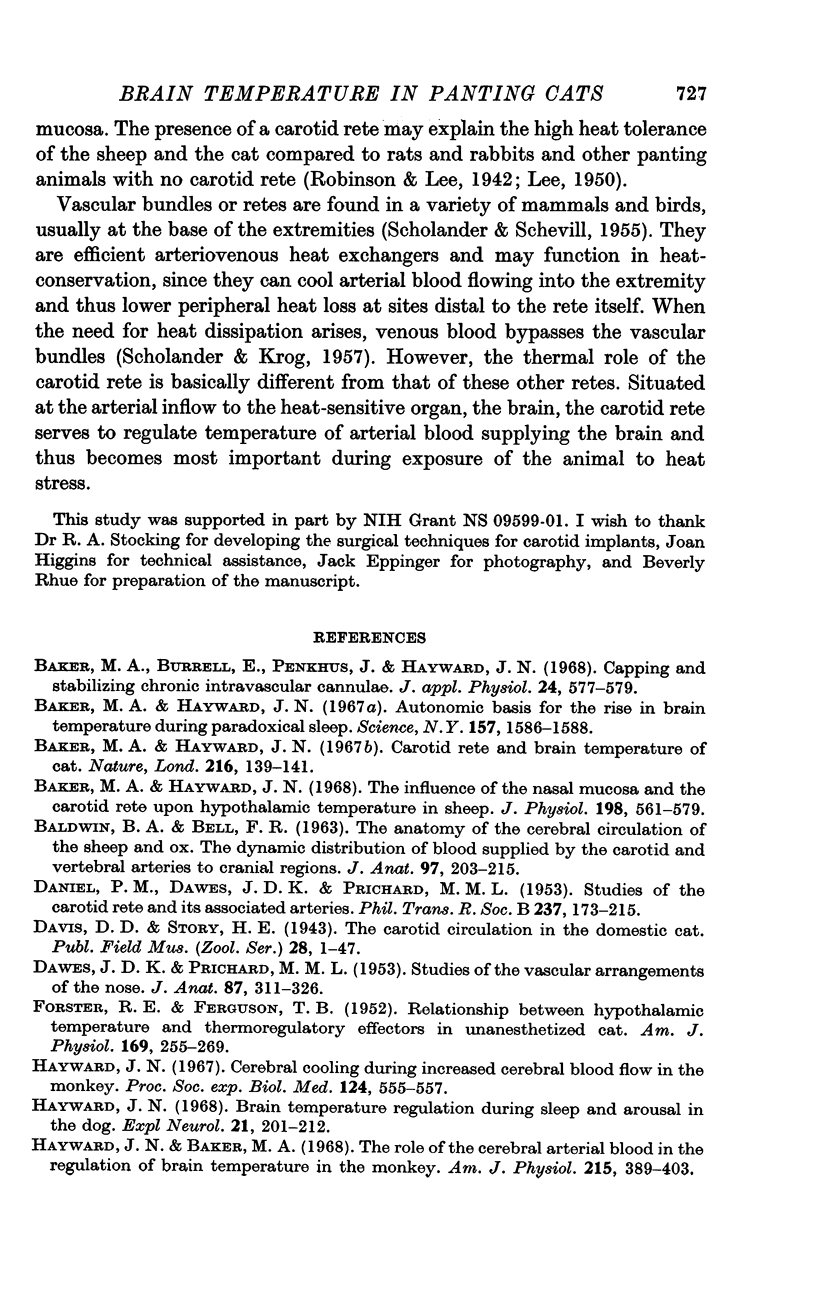
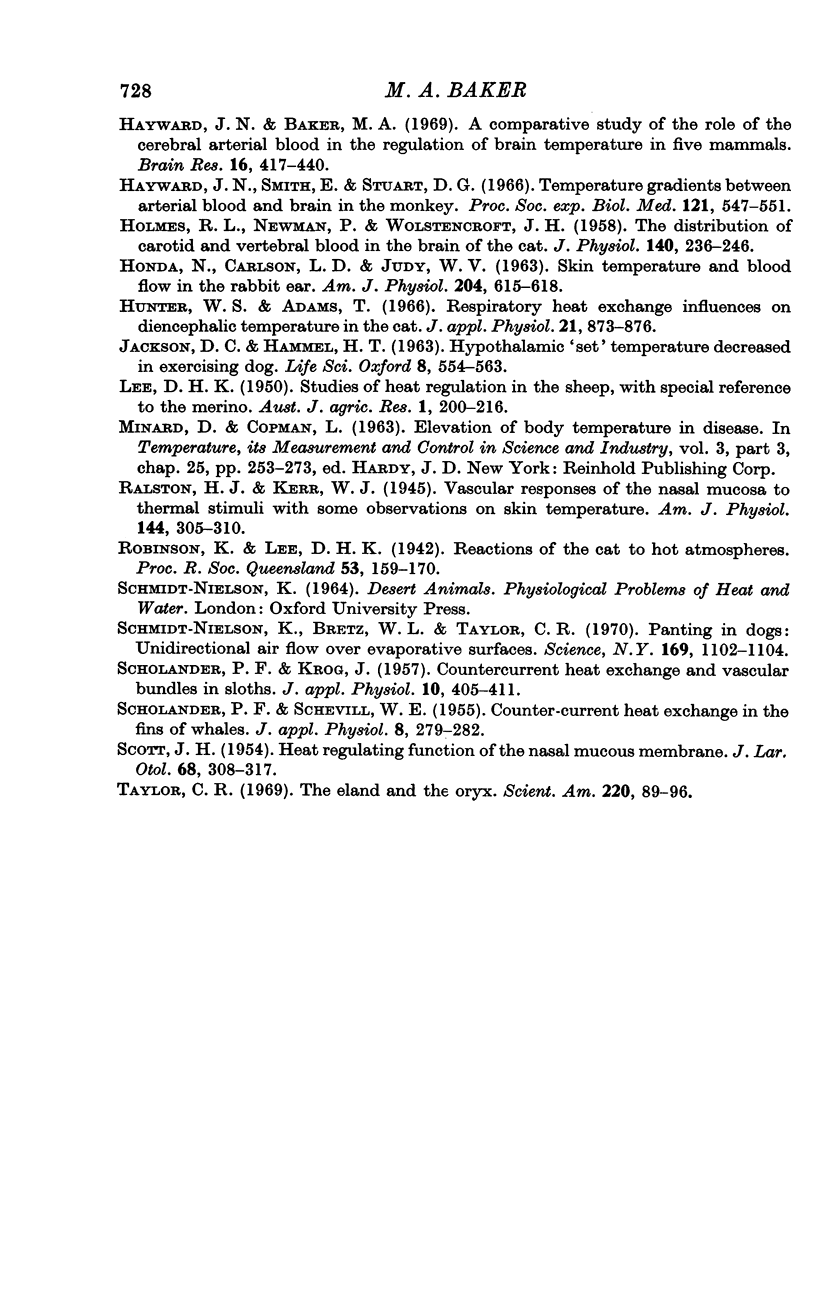
Selected References
These references are in PubMed. This may not be the complete list of references from this article.
- BALDWIN B. A., BELL F. R. The anatomy of the cerebral circulation of the sheep and ox. The dynamic distribution of the blood supplied by the carotid and vertebral arteries to cranial regions. J Anat. 1963 Apr;97:203–215. [PMC free article] [PubMed] [Google Scholar]
- Baker M. A., Burrell E., Penkhus J., Hayward J. N. Capping and stabilizing chronic intravascular cannulae. J Appl Physiol. 1968 Apr;24(4):577–579. doi: 10.1152/jappl.1968.24.4.577. [DOI] [PubMed] [Google Scholar]
- Baker M. A., Hayward J. N. Autonomic basis for the rise in brain temperature during paradoxical sleep. Science. 1967 Sep 29;157(3796):1586–1588. doi: 10.1126/science.157.3796.1586. [DOI] [PubMed] [Google Scholar]
- Baker M. A., Hayward J. N. Carotid rete and brain temperature of cat. Nature. 1967 Oct 14;216(5111):139–141. doi: 10.1038/216139a0. [DOI] [PubMed] [Google Scholar]
- Baker M. A., Hayward J. N. The influence of the nasal mucosa and the carotid rete upon hypothalamic temperature in sheep. J Physiol. 1968 Oct;198(3):561–579. doi: 10.1113/jphysiol.1968.sp008626. [DOI] [PMC free article] [PubMed] [Google Scholar]
- DAWES J. D., PRICHARD M. M. Studies of the vascular arrangements of the nose. J Anat. 1953 Jul;87(3):311–322. [PMC free article] [PubMed] [Google Scholar]
- FORSTER R. E., FERGUSON T. B. Relationship between hypothalamic temperature and thermo-regulatory effectors in unanesthetized cat. Am J Physiol. 1952 May;169(2):255–269. doi: 10.1152/ajplegacy.1952.169.2.255. [DOI] [PubMed] [Google Scholar]
- HOLMES R. L., NEWMAN P. P., WOLSTENCROFT J. H. The distribution of carotid and vertebral blood in the brain of the cat. J Physiol. 1958 Feb 17;140(2):236–246. doi: 10.1113/jphysiol.1958.sp005930. [DOI] [PMC free article] [PubMed] [Google Scholar]
- HONDA N., CARLSON L. D., JUDY W. V. Skin temperature and blood flow in the rabbit ear. Am J Physiol. 1963 Apr;204:615–618. doi: 10.1152/ajplegacy.1963.204.4.615. [DOI] [PubMed] [Google Scholar]
- Hayward J. N., Baker M. A. A comparative study of the role of the cerebral arterial blood in the regulation of brain temperature in five mammals. Brain Res. 1969 Dec;16(2):417–440. doi: 10.1016/0006-8993(69)90236-4. [DOI] [PubMed] [Google Scholar]
- Hayward J. N., Baker M. A. Role of cerebral arterial blood in the regulation of brain temperature in the monkey. Am J Physiol. 1968 Aug;215(2):389–403. doi: 10.1152/ajplegacy.1968.215.2.389. [DOI] [PubMed] [Google Scholar]
- Hayward J. N. Brain temperature regulation during sleep and arousal in the dog. Exp Neurol. 1968 Jun;21(2):201–212. doi: 10.1016/0014-4886(68)90138-6. [DOI] [PubMed] [Google Scholar]
- Hayward J. N. Cerebral cooling during increased cerebral blood flow in the monkey. Proc Soc Exp Biol Med. 1967 Feb;124(2):555–557. doi: 10.3181/00379727-124-31788. [DOI] [PubMed] [Google Scholar]
- Hayward J. N., Smith E., Stuart D. G. Temperature gradients between arterial blood and brain in the monkey. Proc Soc Exp Biol Med. 1966 Feb;121(2):547–551. doi: 10.3181/00379727-121-30827. [DOI] [PubMed] [Google Scholar]
- Hunter W. S., Adams T. Respiratory heat exchange influences on diencephalic temperature in the cat. J Appl Physiol. 1966 May;21(3):873–876. doi: 10.1152/jappl.1966.21.3.873. [DOI] [PubMed] [Google Scholar]
- JACKSON D. C., HAMMEL H. T. HYPOTHALAMIC "SET" TEMPERATURE DECREASED IN EXERCISING DOG. Life Sci. 1963 Aug;8:554–563. doi: 10.1016/0024-3205(63)90106-1. [DOI] [PubMed] [Google Scholar]
- SCHOLANDER P. F., KROG J. Countercurrent heat exchange and vascular bundles in sloths. J Appl Physiol. 1957 May;10(3):405–411. doi: 10.1152/jappl.1957.10.3.405. [DOI] [PubMed] [Google Scholar]
- SCHOLANDER P. F., SCHEVILL W. E. Counter-current vascular heat exchange in the fins of whales. J Appl Physiol. 1955 Nov;8(3):279–282. doi: 10.1152/jappl.1955.8.3.279. [DOI] [PubMed] [Google Scholar]
- Schmidt-Nielsen K., Bretz W. L., Taylor C. R. Panting in dogs: unidirectional air flow over evaporative surfaces. Science. 1970 Sep 11;169(3950):1102–1104. doi: 10.1126/science.169.3950.1102. [DOI] [PubMed] [Google Scholar]


